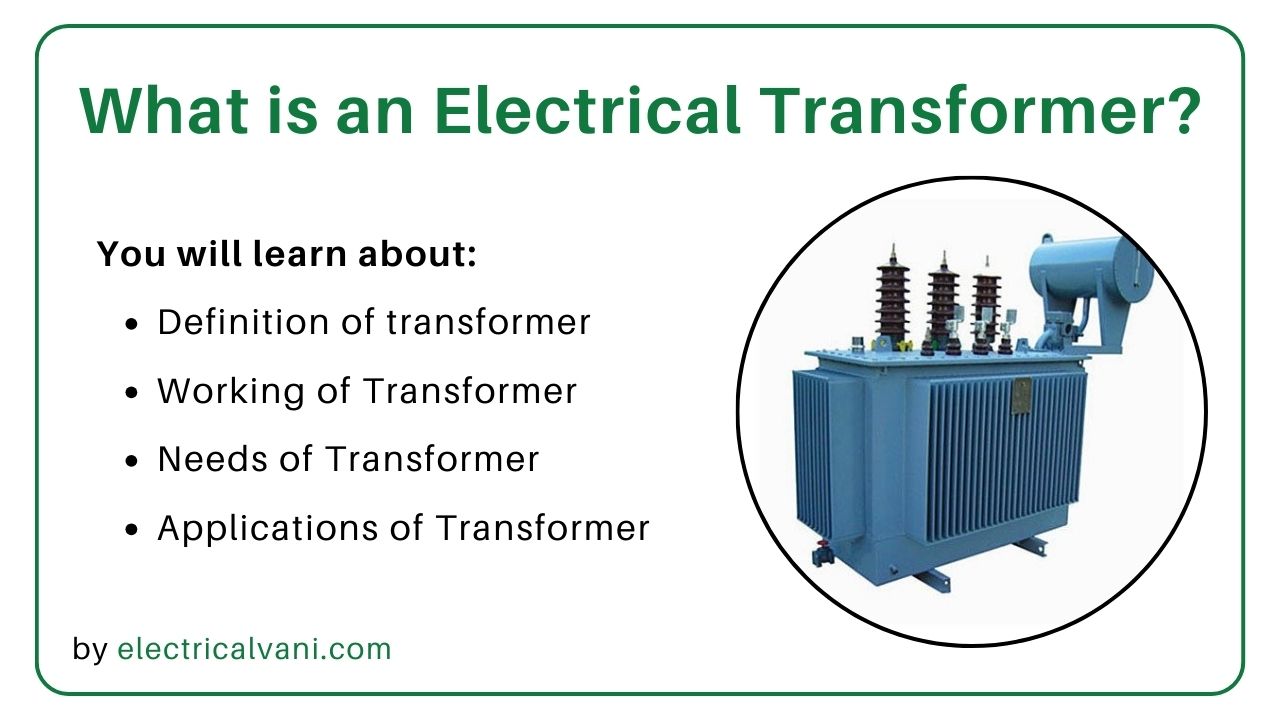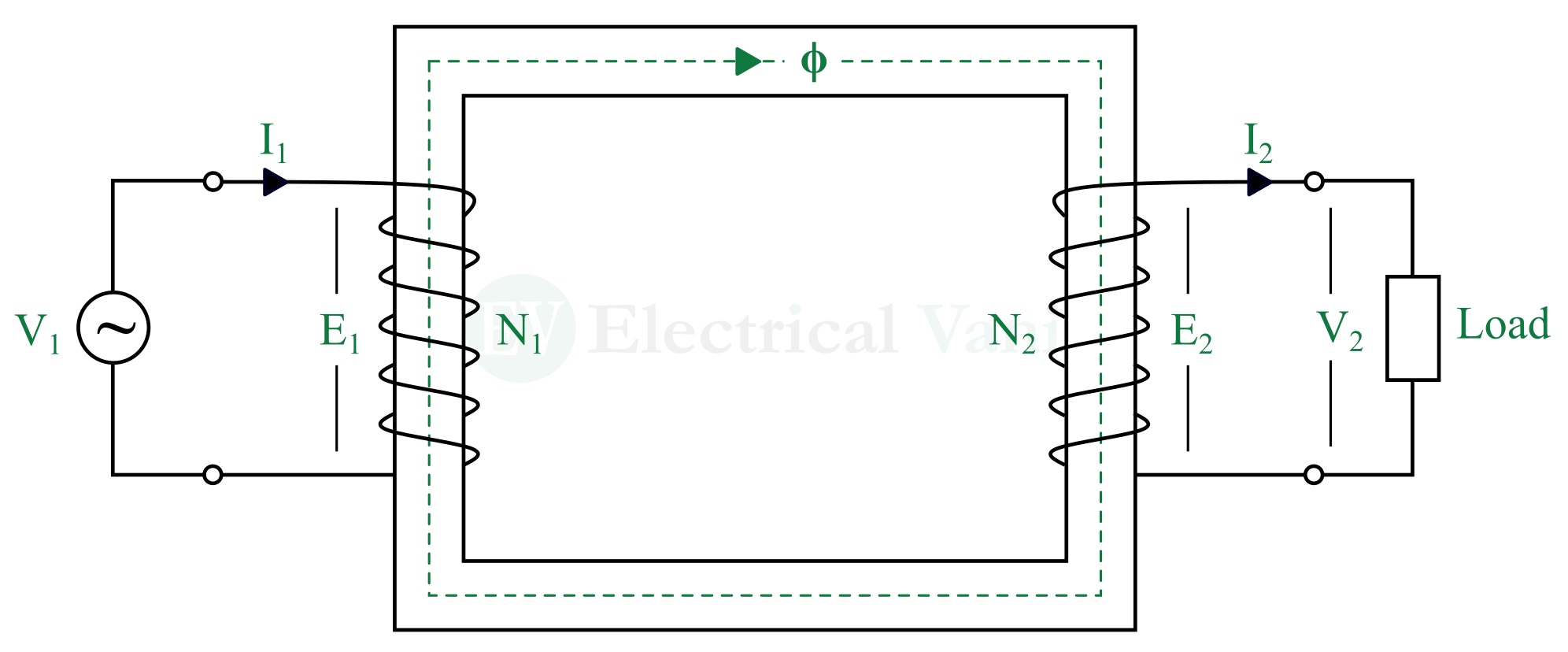In this article on “Electrical Transformer”, we will discuss the definition, working, needs, and applications of an electrical transformer. As we know from our real-life experience, an electrical transformer is one of the most commonly used devices in power distribution systems. The primary function of an electrical transformer is to reduce the supply voltage to a utilization value so that consumers can use that supply voltage to operate their appliances. A typical transformer consists of two windings called primary and secondary. The primary winding is the input side of the transformer and the secondary winding is the output side. The transformer transfers energy from primary to secondary with a change in the voltage and current values. It is also important to note that an electrical transformer is an electromagnetic device that operates on the principle of electromagnetic induction. So, let’s start our study with the basic definition of an electrical transformer.
 What is an Electrical Transformer?
What is an Electrical Transformer?
An electrical transformer is a type of electromagnetic device that is used for increasing or decreasing the supply voltage in an electrical system like a power distribution system. It is an alternating current machine which means it cannot operate on direct current supply, but only on the alternating current or AC supply.
A transformer is a static device which has no moving parts. Therefore, it has a more rigid construction and a very high efficiency of up to 99%.
A simple block diagram of an electrical transformer is shown in the following figure.

It can be seen that a transformer has the following three major components:
- Primary winding – It is the winding of the transformer to which the input AC supply is connected.
- Secondary winding – It is the winding of the transformer from which the transformed output is taken or the load is connected.
- Magnetic core – It is the structure that provides housing to the primary and secondary windings and a low reluctance path for magnetic flux from the primary winding to the secondary winding.
The windings of the transformer are generally made up of copper and the magnetic core is made up of silicon steel laminations.
This is all about a basic introduction to an electrical transformer. Let us now understand “How does the electrical transformer work?”.
Working of Electrical Transformer
First of all, we need to know that the working of an electrical transformer is based on the principle of electromagnetic induction, more specifically, the principle of mutual inductance.
To understand the working of an electrical transformer, let us connect an AC voltage to the primary winding and an electrical load to the secondary winding as shown in the following figure.

The alternating input voltage V1 sets up an alternating magnetic flux in the core which flows through the magnetic core to the secondary winding. This magnetic flux induces an EMF E2 in the secondary winding by the electromagnetic induction.
Since a load is connected across the secondary winding, it completes the circuit and a current I2 flows in the secondary winding circuit. Due to this secondary current, a voltage V2 appears across the load, which is called output voltage or secondary voltage.
The value of the output voltage can be less than or greater than the input voltage depending on the number of turns in the primary and secondary windings. Let’s say, N1 is the number of turns in the primary winding and N2 is the number of turns in the secondary winding. Then,
- If N1 > N2, then the output voltage will be less than the input voltage i.e., V2 < V1. This transformer is called a step-down transformer.
- If N1 < N2, then the output voltage will be greater than the input voltage i.e., V2 > V1. This type of transformer is called a step-up transformer.
It is also important to note that a transformer does not have any electrical connection between the primary and secondary windings. Instead, it has a magnetic coupling between them.
Needs of Electrical Transformer
This section will explain “why a transformer is required in electrical systems”. As we already know, an electrical transformer is used to increase or decrease the values of voltage and current in electrical circuits.
The following are some common reasons why we use electrical transformers:
- Electrical power is generated at high voltages like 11 kV, whereas appliances like motors, fans, computers, etc. are designed to operate at lower voltages such as 240 V, 440 V, 3300 V, etc. Therefore, to transform the high voltages from transmission lines to the low voltages, we use an electrical transformer.
- Transmission and distribution of electrical power is done at different voltage levels. Therefore, transformers are also used for voltage transformation in power systems.
- Some special types of transformers like current transformers (CTs) and potential transformers (PTs) are used in power system protection and measurement.
Till this section of the article, we have learned about the fundamentals of electrical transformers. Now, it’s time to know the practical applications of transformers.
Applications of Electrical Transformer
A transformer is used for raising or lowering AC voltage or current in an electric current. It is commonly used in the following:
- Power generating stations
- Transmission substations
- Distribution substations
- Mobile, laptop, and battery chargers
- Telecommunication systems
- Motor control circuits, etc.
Conclusion
This is all about the electrical transformer, its working and applications. In this article, I have explained all the fundamental concepts of electrical transformer. Still, if you have any doubts, please let me know in the comment section.
FAQs Related to Electrical Transformer
Some commonly asked questions related to electrical transformers are answered below.
Q. 1 – What does an electrical transformer do?
Ans – An electrical transformer changes the value of voltage and current, either increase or decrease.
Q. 2 – What are the 3 types of transformers?
Ans – As per voltage transformation, there are following three types of electrical transformers:
- Step-up transformer – It increases the value of voltage.
- Step-down transformer – It decreases the value of the voltage.
- Isolation transformer – It does not change the voltage level, instead, it provides isolation between input and output electrical circuits.
Q. 3 – What is transformer working principle?
Ans – The working of the electrical transformer is based on the principle of mutual inductance between two coils placed near to each other.
Q. 4 – Do transformers work on AC or DC?
Ans – A transformer works on AC only; it cannot work on DC because DC cannot provide electromagnetic induction which is the fundamental concept behind the operation of the transformer.
Q. 5 – What are the 5 functions of transformer?
Ans – The following are the five major functions of a transformer:
- Increase the voltage and current.
- Decrease the voltage and current.
- Isolate two electrical circuits electrically.
- Couple two electrical circuits magnetically.
- Change the voltage level without changing the power and frequency at the input and output.